Chinese imperial filigree, gilt and polychrome enamelled silver lidded box inlaid with precious stones, Qianlong
They say - "For further examples of similar work". A brief look at the objects listed and illustrated below will provide better examples for comparison.
Sotheby's, Hong Kong, Nov. 25, 2013, lot 16, for a related snuff bottle.
Sotheby’s New York, 3rd October 1980, lot 181.
Belfort Collection, 1986.
.....................................................
Bonhams, London, May 17, 2012, lot 124, for a related snuff box was looted by General John Hart Dunne from the Summer Palace in Beijing in 1860. (see below).
This provenance from the Summer Palace is particularly
interesting - in that it suggests that such boxes were not made
solely for export but were also appreciated in Imperial China. (direct link
available on rm-auctions.com).
What it doesn't say is where and when it was made.
- Two related silver filigree boxes from the Main Hermitage
Collection in St Petersburg were included in the exhibition Treasures of
Catherine the Great, held at Somerset House, London, 2001-2001, Catalogue,
no.364. (see image below)
- A somewhat related reticulated basket is with Pushkin
Antiques, London. (see images below).
Chinese Imperial documentary enamelled silver gilt filigree box and cover late 18th/early 19th century, decorated with a stone chime or qing suspended from a stylized bat encircled by scrolling foliage, flowers and peaches, the sides with bats and lotus, all on a ground of tight scrolls.
The interior of the lid is inscribed 'Taken by General John Hart Dunne from the Summer Palace, Pekin, 1860, and given to him by his uncle, the Revd. Richard Hart of Catton, Norwich, with whom and his widow Jane Hart it remained until 1897'.
Provenance: The Summer Palace, Beijing, 1860. General Sir John
Dunne (d.20th April 1924).
Length: 10.5cm, diameter: 2cm.
Suggested by Michael Backman as from Batavia, Indonesia.
I think possibly Chinese.
Once again I am very grateful to Michael Back for permission to use the photographs from his excellent website.
8 x 9 x 7cm
An almost identical acorn-shaped bezoar or goa stone holder
was successfully sold at Spink and Son, Wednesday 13th April - Friday 6th May
1988, lot 90.
"Conventionally, eighteenth century filigree boxes such as
this example are ascribed to Chinese manufacture, most typically to Guangdong (Canton).
Certainly some aspects of the work relates to boxes and other items of vertu
that also contain elements that firmly indicate China as their place of origin
– see for example a pair of square silver filigree boxes and covers illustrated
in Chan (2005, p.59).
Jackson & Jaffer (2004, p.232) illustrate a silver-gilt
tea caddy in London’s Victoria & Albert Museum, from Canton, China and
attributed to circa 1760, which has similar filigree work in terms of its
fineness and the rococo-like flourishes.
But whilst the leafy flourishes on this box are rococo in
appearance they might also be interpreted as of traditional Malay design with
its Islamic aesthetic. Indeed the work has much in common with the fine silver
filigree work undertaken in Sumatra, Indonesia in the eighteenth century.
Sumatran filigree work in centres such as Padang and Lampung may well be
influenced by examples from China and or the local artisans themselves may have
been of Chinese descent, hence the confusion between some Sumatran-Malay
filigree and some Chinese work from China. The wispy foliage work on the box
here is reminiscent of that engraved on ceremonial gold Javanese headdress
ascribed to the sixteenth century and illustrated in Ibbitson Jessup (1990, p.
211)".
Archer, M. et al, Treasures from India: The Clive Collection at Powis Castle, The National Trust, 1987.
Chan, D.P.L, Chinese Export Silver: The Chan Collection, published in conjunction with the Asian Civilisations Museum, Singapore, 2005.
Length: 9.7cm, width: 1.2cm
Refs below from Michael Backmans website.
Gelman Taylor, J., The Social World of Batavia: Europeans
and Eurasians in Colonial Indonesia, 2nd ed., The University of Wisconsin
Press, 2009.
This needle case is the same work and indeed must be from
the same maker as a small lidded box that was on loan to Amsterdam’s
Rijksmuseum and attributed to Batavia around 1700.
That box is illustrated in Corrigan et al (2015, p. 98). The
box belonged to Petronella van Hoorn (1698-1764) who returned to Amsterdam from
Java in 1710. It remained with her descendants until recently.
That box appears to be the same box formed part of a lot
subsequently sold at Christie’s London in 2017 and in 2016, Sotheby’s sold a
rectangular box with similar work that was incorrectly catalogued as
Indo-Portuguese India and attributed to the 17th-18th century.
Petronella van Hoorn divided her year between Rosendael Castle near Arnhem, and her home in Amsterdam, on her return to the Netherlands from Java. It is believed that Petronella had other items in her filigree collection but the whereabouts of these is not known.
Refs.
Corrigan, K., J. van Campen, & F. Diercks (eds.), Asian
in Amsterdam: The Culture of Luxury in the Golden Age, Peabody Essex
Museum/Rijksmuseum, 2015.
Zandvlieyt, K. et al, The Dutch Encounter with Asia
1600-1950, Rijksmuseum Amsterdam, 2002.
Following the death of her first husband, Petronella van Hoorn remarried Lubbert Adolf Tork in 1722, who in 1721 had inherited Rosendael Castle near Arnhem.
Petronella, who acquired the silver filigree circular box
and cover in this lot, had formed a collection of filigree, which is described
in the catalogue of contents of Rosendael Castle as well as her home in
Amsterdam on the Herengracht.
Ref. Karina H. Corrigan, Jan van Campen, Femke Diercks,
Janet C. Blyberg eds., Asia in Amsterdam, The Culture of Luxury in the Golden
Age, (New Haven and London,
2015), p. 98.
H. 31.6 and 31.7 cms
For another similar work but to a different round shaped box, please see the Dutch-Colonial Batavian filigree box, catalogued on Asia In Amsterdam, The Culture of Luxury In The Golden Age, Peabody Essex Museum, Salem, Massachusetts, In Conjunction with The Rijksmuseum, Amsterdam, Distributed By Yale University Press, New Haven And London, Lot No. 20 pages 97-98.
From the AJ Antiques website -
For the Ottoman three dots motif, please see Cosmophilia, Islamic Art from the David Collection, Copenhagen, by Sheila S. Blair & Jonathan M. Bloom, lot 45 page 115. For various European made objects that bears the three dots motif, please see Impressions of Ottoman Culture in Europe: 1453-1699, Illustration No. 32 page 65 & lot no. 62 page 92.
The
box is marked with various European import silver marks, one of which is
probably of an 18th century venetian mark, the others are of a 19th century
French swan motive marks.
For another similar work but to a different object, please
see the Dutch-Colonial Batavian filigree box, catalogued on Asia In Amsterdam,
The Culture of Luxury In The Golden Age, Peabody Essex Museum, Salem,
Massachusetts, In Conjunction with The Rijksmuseum, Amsterdam, Distributed By
Yale University Press, New Haven And London, Lot No. 20 pages 97-98. For
similar work but to a different object, please see the pair of rosewater
sprinklers, Treasures from India, The Clive Collection at Powis Castle, Mildred
Archer, Christopher Rowell & Robert Skelton, lot No 188 pages 115 &
127.
For a similar rosewater sprinkler to the above pair, please
see, Sotheby’s Arts of the Islamic World, London, the 24th. April 2013, sold
lot 219.
For a similar item, please see, Sotheby’s Arts of the
Islamic World, London, on the 20th. April 2016, sold lot 140.
Very poor image courtesy National Trust Collections website - the inscriptions are illegible.
Quite why the NT provide such poor quality images remains to be discovered.
Sprinklers Height 32 cms. - Saucers Diam 13.5cms.
Believed to have been brought from India by Henrietta Herbert, Lady Clive (1786 - 1835).
The saucers bear the inscription "These Gulab Dauns were found in the sleeping apartment of Tippoo Sultaun on the 4th May 1799 when Seringapatam was taken by storm & Tippoo was slain. They were presented to the Countess of Powis"

"The pair has as its provenance, the Duke of Portland. The pair is listed in the 1935 inventory of the then Duke’s collection of silver housed at Welbeck Abbey, the Duke’s country seat. (see Jones, 1935, p. 8). They are listed as: ‘A pair of filigree bottles with globular bodies. Height, 8 3/4 in. Maltese (?), early 19th century’. The dating and origins were a likely best guess.
It is not clear how this pair entered the collection. However, Jones’ introduction to the inventory mentions that the family’s collection of silver is the result of several family inheritances, including a quantity of silver items brought to England by Hans William Bentinck, a Dutch and English nobleman who became the first Duke of Portland. Bentinck lived in England and Holland variously in the late 17th century and in 1690 was sent by William III to The Hague on a diplomatic mission.
It is doubtful that the sprinklers are as early as this but the family’s early origins in and connections with underscore the possibility that the sprinklers are the product of United East India Company or Vereenigde Oost-Indische Compagnie (VOC) related workmanship in Batavia (or possibly China) and were exported to Holland from where they were acquired by the family and brought to England"
Singapore Museums.
Lot 156 - 9 -16 November 2021.
The tray behind is Ottoman Turkish and not related.
Sprinkler 32.5 cm high.
Height - 6.5 cms, width -16 cms, depth - 14 cms.
Like many European rulers during the 18th century, Russian Empress, Catherine the Great, loved filigree and she amassed the world’s largest single collection of Chinese silver filigree, now housed in the State Hermitage Museum in St Petersburg. This box is almost identical to a set of seven similar caskets which formed part of Catherine the Great’s 32 piece silver filigree toilet set. Please refer to the photograph below (last image) which shows only five of the boxes.
Queen Charlotte, wife of George III of England was another devotee of
Chinese filigree.
Height: 6.7cm, length: 16cm, width: 12cm.
Michael Backman suggests that these objects might be manufactured in Batavia but I am doubtful.
More research is needed.
The taste for ‘things Chinese’ was well developed in Russia
by the eighteenth century. Merchants and embassies were requested to source
items for the Russian court that were Chinese or at least had the appearance of
being Chinese.
Russia did not have its own East India Company equivalent. It traded with China by land or ordered goods from the East India companies of other European nations, most particularly the VOC of the Dutch. It is quite possible that Chinese-looking items ordered from the VOC were assumed in Russia to have their origins in China rather than Batavia or India.
Voskuil-Groenewegen, S.M. et al, Zilver uit de tijd van de Verenigde Oostindische Compagnie, Waanders Uitgevers, 1998;
Chan, DPL, Chinese Export Silver: The Chan Collection, published in conjunction with the Asian Civilisations Museum, Singapore, 2005.
I haven't as yet had access to these two publication.
I own a copy of the catalogue below which is useful for comparison with other filigree objects but is now out of date in the light of my recent researches - much of the information within is based on supposition and should be treated with caution.
Piotrovsky, M. et al, Silver: Wonders from the East – Filigree of the Tsars, Lund Humphries/Hermitage Amsterdam, 2006.
.............................................
A closely related box sold by Christies.
Perhaps from the same workshop.
28 June 2007.
15.5 cms wide.
Inscribed to the interior cover B.W & A.W - 1885-1935
Why they post such poor images is anybodies guess?
https://www.christies.com/en/lot/lot-4938958
.............................................................
and another sold Bonhams.
18 cms wide.
Lot 137, 9 March 2004.
The interior brightly gilt and incised to the cover with the arms of Smythe-Pigot
Paragraphs below from Bonhams Catalogue.
The arms of the Smythe-Pigots were granted in 1824, following the marriage in 1815 of Anee Pigot and John Smythe.
It is known that similar boxes were in the Royal collection of Queen Charlotte, which was sold at auction by Christie's in 1819.
It is therefore not inconceivable that this
box was formerley in the Royal collection, purchased at Christies by the
Smythe-Pigots in 1819, and engraved around 1824.
https://www.bonhams.com/auctions/10780/lot/137/?category=list
_________________________
The Hermitage St Petersburg Boxes.
One should be thankful for small mercies but their website is not very good.
The resolution is mostly very low and whoever compiled it did not view the Hermitage Amsterdam Catalogue by Menshikova.
Apparently there are seven of these boxes. A single large box and three smaller boxes.
supposedly part of a toilet set. Transferred from the entresol of Catherine the Great's Winter Palace in 1789.
Hermitage Museum Box 1.
16 x 13 x 6 cms.
https://www.hermitagemuseum.org/wps/portal/hermitage/digital-collection/08.+applied+arts/579942
....................................................
The Hermitage Pair of Chinese Silver Gilt Filigree Boxes 2.
13.5 x 5 x 5.5 cms
https://www.hermitagemuseum.org/wps/portal/hermitage/digital-collection/08.+applied+arts/579943
...................................................
Hermitage Silver Gilt Filigree Box 3.
17 x 6.5 x 13 cms.
https://www.hermitagemuseum.org/wps/portal/hermitage/digital-collection/08.+applied+arts/580551
................................
Hermitage Silver Gilt Filigree Box 4.
17 x 6.5 x 13 cms.
https://www.hermitagemuseum.org/wps/portal/hermitage/digital-collection/08.+applied+arts/580550
............................................
Hermitage Silver Filigree Box 5.
17 x 13 x 6.5 cms.
References below: From the Cohen and Cohen website.
Related parcel-gilt silver examples are illustrated in Chen 1999, Enamel Ware in the Ming and Ch’ing Dynasties, no. 164, p. 290, a slightly later example; in Palace Museum,
The Imperial Packing Art of the Qing Dynasty (2000), no. 120, pp. 240–1; and in Yang 1987, Tributes from Guangdong to the Qing Court, no. 40, p. 81, dated Yongzheng; a parcel-gilt silver casket, dated 1740–50s, in Arapova et al 2003, Chinese Export Art in the Hermitage Museum: Late 16th–19th centuries, cat. no. 154, p. 144.
A small silver box in the same style, with an inscription stating that it was taken from the Summer Palace 1860, is in a private collection, with provenance to an English country house with descendants of a military man in China 1860 (Gen. Hart Dunne - illustrated here)
Cohen & Cohen 2013, p92, a pair of silver candlesticks from the same workshop;
Cohen & Cohen 2014B, p27, No 14, another box with a hinged cover;
For other
related silver examples, see Piotrovski 2000, Treasures of Catherine the Great,
no. 352, p. 213, in the shape of a cloud, and no. 364, p. 218, two boxes, dated
mid eighteenth century, with festooned sides.
L. 17.5 x W. 11.7 x H. 11.2 cm (including lid)
Dimensions: base 16x23 cm, height 16 cm.
Canton circa 1860?
They say Qing dynasty. Each of inverted ogee form upon four short bracket feet with adjoining shaped aprons, each with flat chased decoration of rosettes, peonies, and trailing foliage. The sides with plain sections flanked with twisted wire. The opposable swing handles formed as floral sections with cloisonné enamel of blue and green heightened with gilt flower heads, the central rosettes additionally with yellow and puce enamel.
The domed pull off
lid with a central, European initial S in gothic script surmounted by a
coronet, matted and with a bright cut edge. The body and lid with woven
filigree of swirling roundels, applied with cloisonné enamel wirework, each
side with a fisherman and his net, a tree, a house, the sides with a rural
scene of oxen, a farmer and buildings, the lids with buildings, a farmer
ploughing a field, all interspersed with trailing foliage, each in a five
colour-way enamel. Some losses throughout of applied sections.
Each: 18cm (7 1/8in) wide.
9 inches long by 6.75 inches deep by 6 inches high.
The handle is indented with the Pantatome and Criquet marks used in France from 1818 -38 designating silver of a foreign origin (Tardy, p. 198).
The
base and cover are stamped with the Paris mark indicating a fineness of 800
silver (Tardy, p. 193).
The quality of this basket resembles the style of a well respected Canton retail silversmith Cutshing, who was renowned for creating enamelled and jeweled filigree items for the European Royal households, the Russian imperial court, Arab Sultanates and Maharajah's palaces.
A very similar
example can be seen at the Hermitage Museum (Winters Palace, St-Petersburg)
that was once used by Catherine the Great (reign 1729-1796).
The top of the lid has an oval cartouche engraved with the Mainwaring coat of arms, the family name goes back as far as the Norman Conquest of 1066, This family originally known as the Mesnil Warin, brought to England from France by William the Conqueror, who generosity gave his family and friends most of the land previously owned by the Anglo-Saxon aristocrats.
According to Sir Bernard Burke, this coat of arms was awarded to the family of Mainwaring in Over Peover, Chester by Ranulphus de Mainwaring, (son of
Eudes-au-Capel "Dapifer" de la Haye, Baron of La Haye, Senechal of
Normandy), who accompanied Conqueror of England. The Mainwaring family owned
majority of there land in Over Peover, co, Chester and had notable wealth and
closely involved in politics.
Length of arm: 21cm, width of arm: 2.5cm, width of unfolded
fan: 35cm.
Dimensions: Height: 8.75 in (22.23 cm)Width: 12 in (30.48
cm)Depth: 1.5 in (3.81 cm)
(34.3 x 8.3 x 6.7 cm)
908 York Road Towson, MD 21204
United States
Late 19th century silver gilt filigree oval Bodkin Case, with applied scrolling filigree
Height 4.5 in.
The workmanship on this case should be compared with that on "another fan" illustrated above.
Height: 10.2cm, width: 7.2cm, thickness: 1.1cm,
Chinese export silver filigree visiting card case is
interesting because it is unusually fine, comes in its original box, and is
from a retailer/maker that has barely been heard of.
It is made entirely of silver filigree other than for a small silver plaque to the top of the lid which most probably was intended to be engraved with an owner’s initials. The filigree is unusually fine even by the standards of Chinese export silver. The sides are of fine silver lattice-work. The front and back
https://auctionet.com/en/events/421-autumn-fine-art-sales-october-2022/357-a-19th-century-chinese-filigree-work-casket
are of decorated in high relief (in filigree)
with panels that include dragons, a pair of fish and what might be a bat,
within borders of tight filigree scrollwork.
The case comes in its original case made of stiff paper or
board. The outside is covered with woven Chinese silk textile. The interior is
lined with an orange-red textile. A paper label glued to the inside of the lid
reads, ‘Khechoungming Gold Dealers & Silver Smith from Canton’. To date, we
have found no published record of this retailer/maker.
Forbes et al (1975,
p. 41-42) comments that the Chinese were well known for their meticulous care
in packaging and notes the usefulness of original boxes and other packaging
with the maker’s name allowing us to thus identify the maker in the absence of
other (scarce) means of establishing this: ‘…boxes are rare, and labelled boxes
even rarer…’ says Forbes.
There is no obvious damage to the case. The storage box,
being original, is in a more fragile state.
Refs.
Chan, D.P.L., Chinese Export Silver: The Chan Collection,
published in conjunction with the Asian Civilisations Museum, Singapore, 2005.
...................................................
19th Century Silver Filigree and Enamel Card Case.
Heritage Auctions.
Lot 68648, 14 June 2014
10.2 x 6.7 cm
___________________________________________________
A Magnificent Table Ornament.
Sotheby's Lot 22, 10 December 2020.
Catalogued as 2nd Half of the 18th Century.
in early 20th century dark blue velvet lined wood case, with
label : 'CABINET MAKER Dorabji N. Mistry 18 Tamarind Lane, Fort, BOMBAY'
________________________________________________________
A mystery object.
Lawrence's Auction House Silver Filigree Casket.
Width 6 inches.
Sold Lot 357 October 2022.
I'm not sure what to make of this object The panels are obviously Chinese in style but the filigree work is very loos in comparison with Chinese objects illustrated above.
Was it made in Indonesia using Chinese Elements?
Was it made in Holland using Chinese Elements?
____________________________________________________________
Conclusions.
I would like to have said that I have contributed to the identification of the dates and sources of Chinese filigree but it is impossible to make that claim.
The workmanship on all these pieces is remarkable.
It has proved almost impossible to date many of these objects without secure provenances.
It would seem that the manufacturers of these objects were innately conservative using the same techniques over several centuries into the 20th century.
Most of the card cases which appear to have been made after 1830 when the use of calling cards became popular (to confuse issues the card case at Powis Castle is possibly the toothpick case listed in a 1774 inventory - within it is a manuscript note recording it as a gift from Sir John Malcolm to Henrietta Herbert, Lady Clive - according to this note it came from Chrikacole (Chickacole) in the Northern Circars between Orissa and Masulipatam on the Indian East coast).
The inscribed rosewater sprinklers from the Clive Collection at Powis listed in inventories of 1774 and again in 1775 are perhaps useful indicators of Chinese 18th century workmanship.
see my post - https://antiqueeuropeanfiligree.blogspot.com/2023/02/18th-century-indian-filigree-at-powis.html
The Casket looted from The Winter Palace at Peking by Hart Dunne could have been made at anytime prior to 1860 over a period of two centuries.
A subject to return to and expand upon in due course!











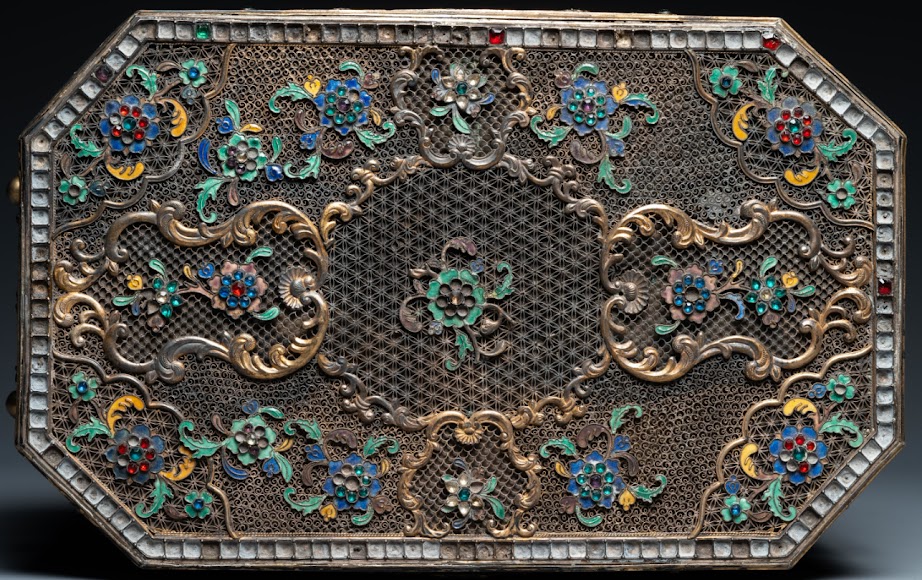



































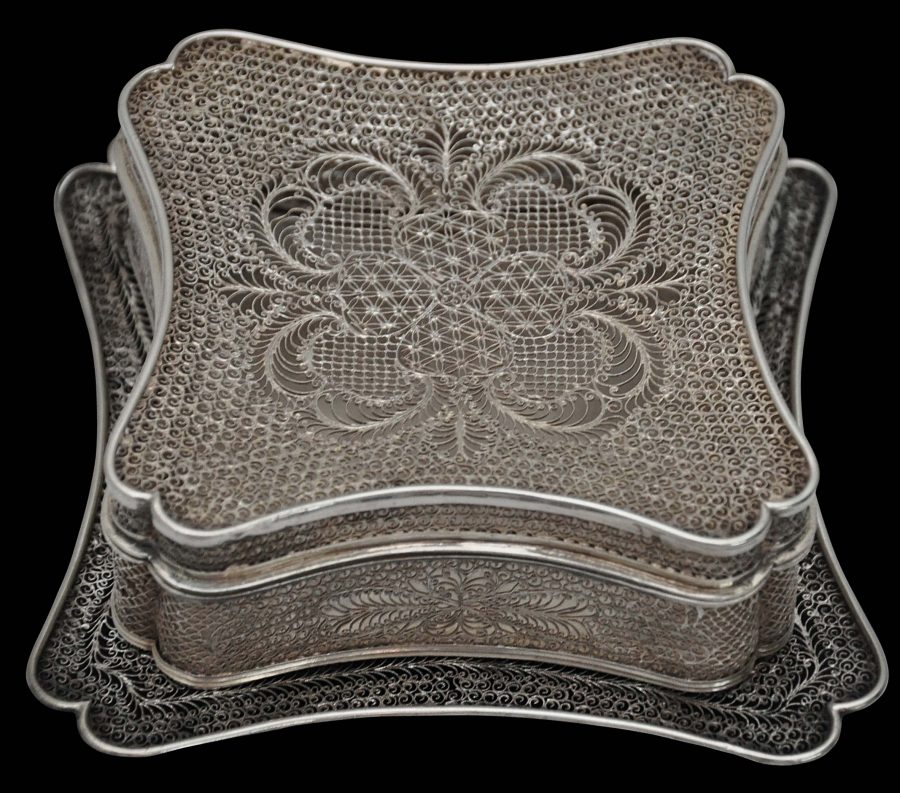









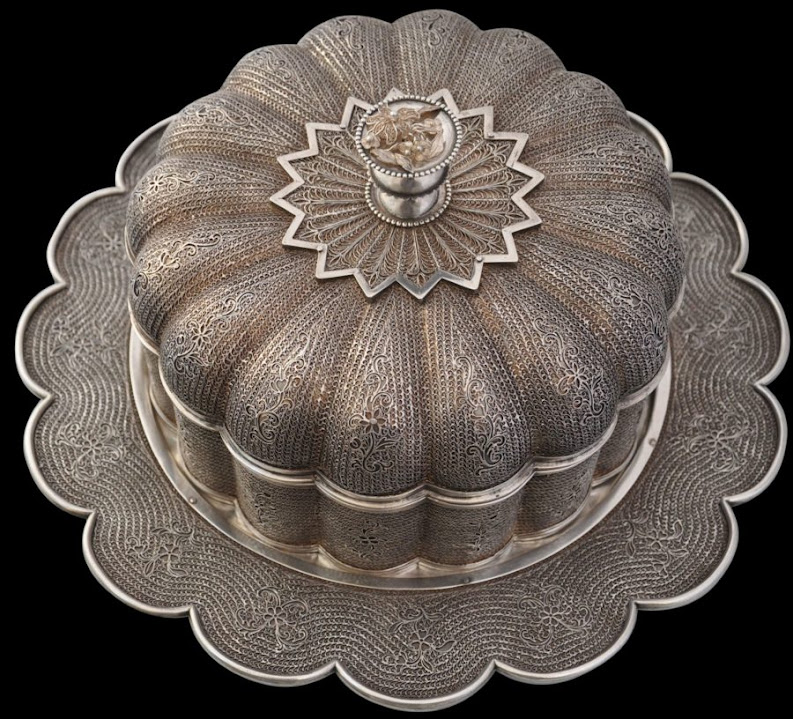





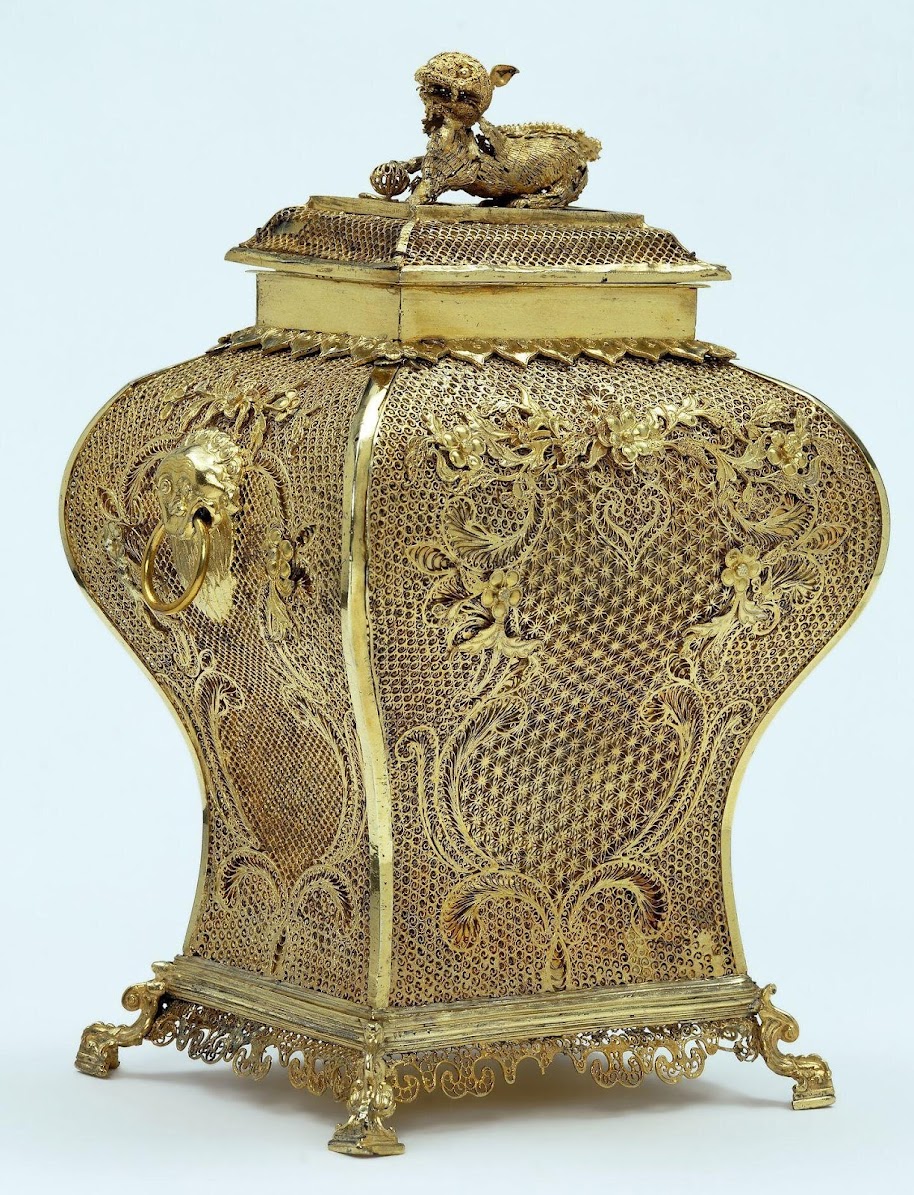












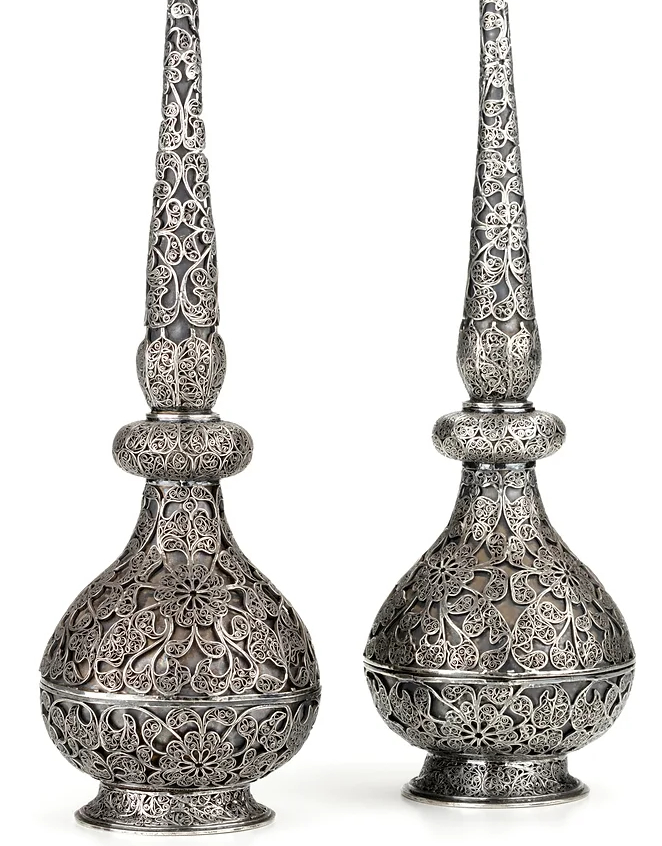




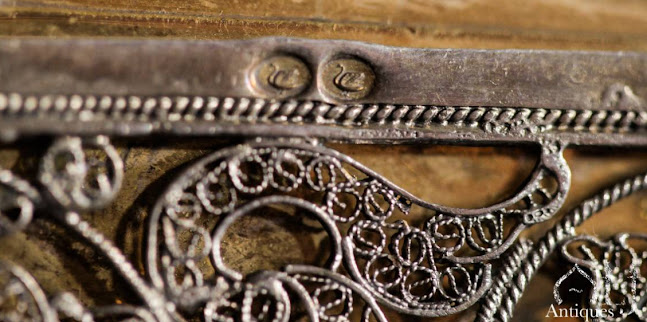








































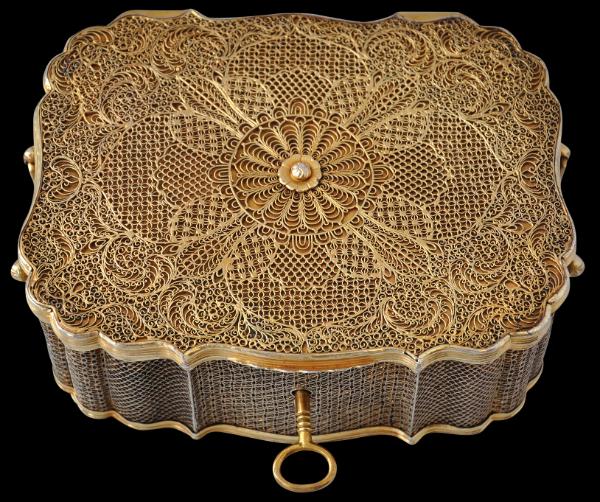






.jpg)
%203%20piss%20poor%20res.jpg)
%204.jpg)
%205%20adj.jpg)
%202.jpg)
%20Height%2055.8%20cms.jpg)
%20Height%201112%20cms.jpg)






.jpg)
%20campo%20ligure%20museum%20adj.jpg)




























.jpg)






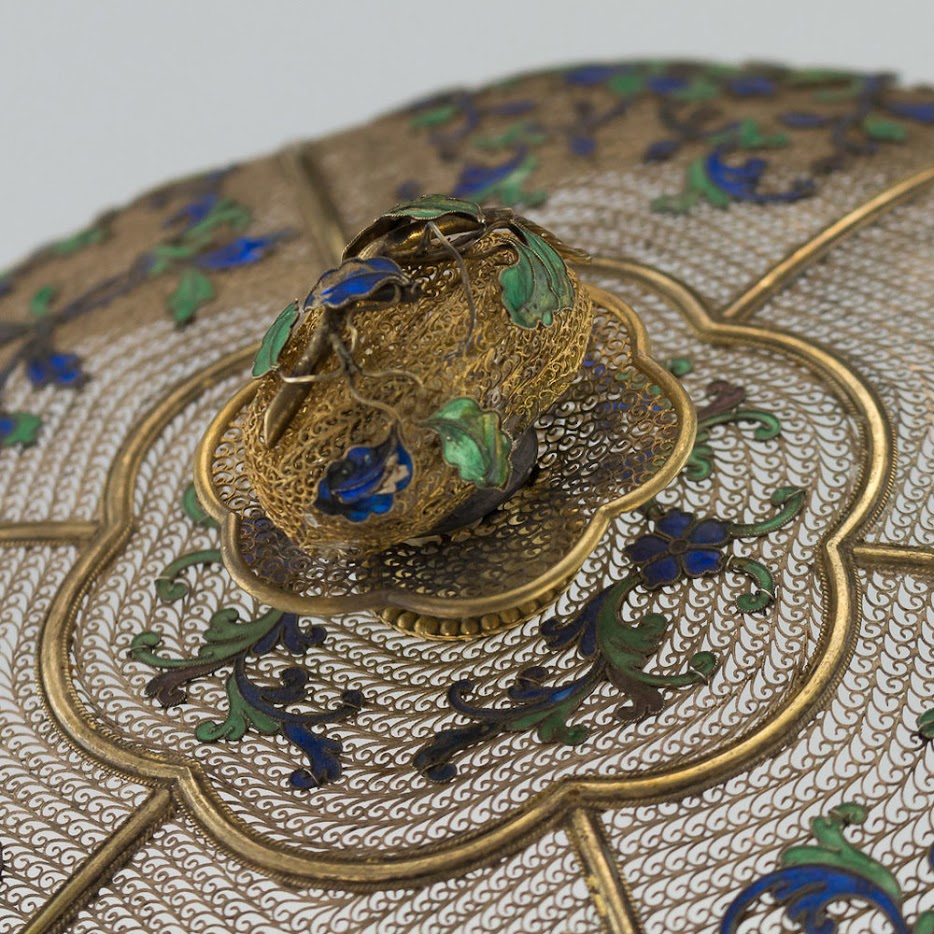








%20Height%2019cms%20adj.jpg)



%20Hermitage%2019,5x23%20cm.jpg)
23%D1%8517%D1%8519,5%20cm%20adj.jpg)





























































No comments:
Post a Comment